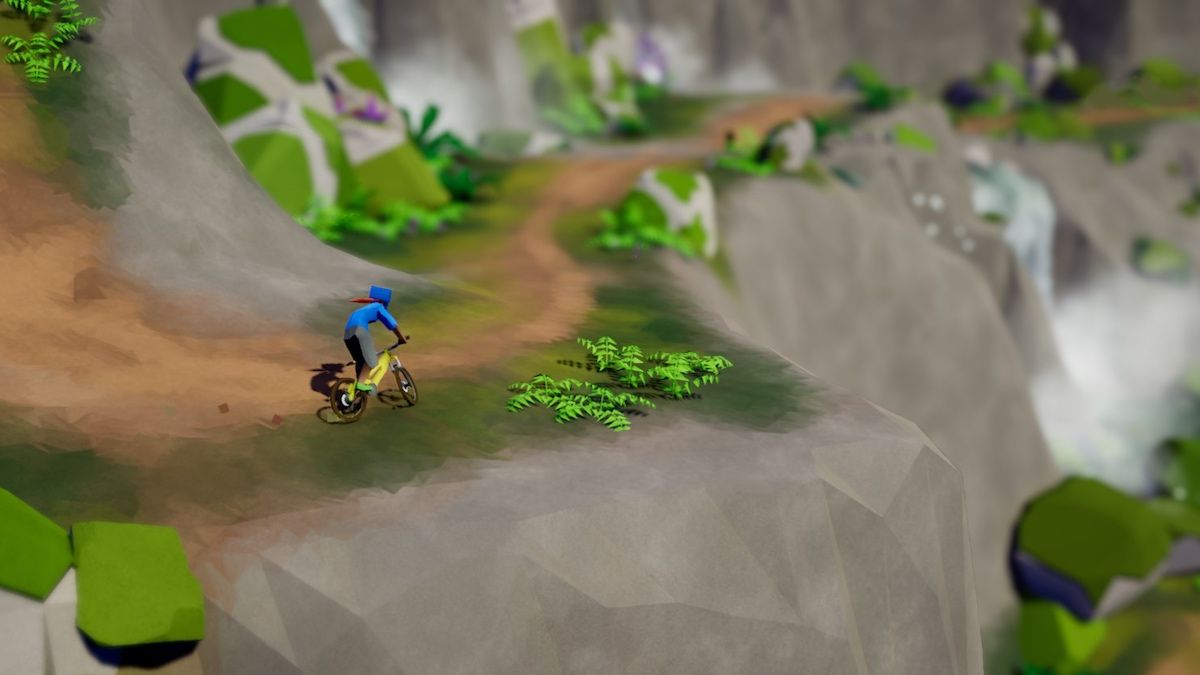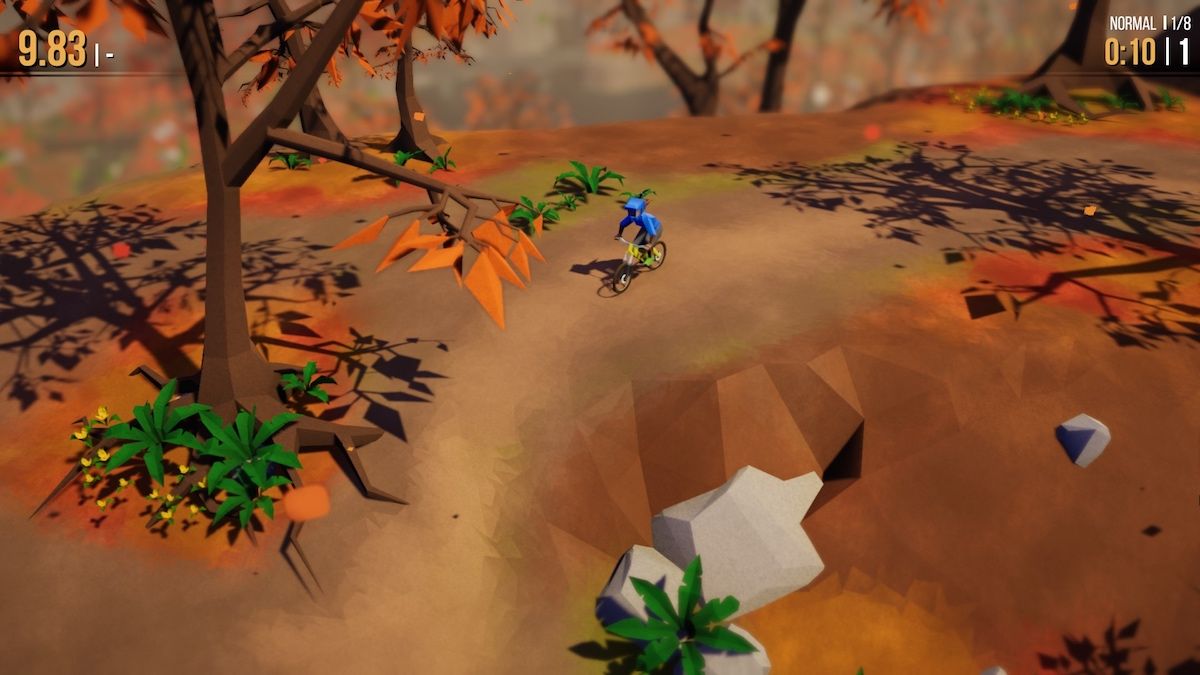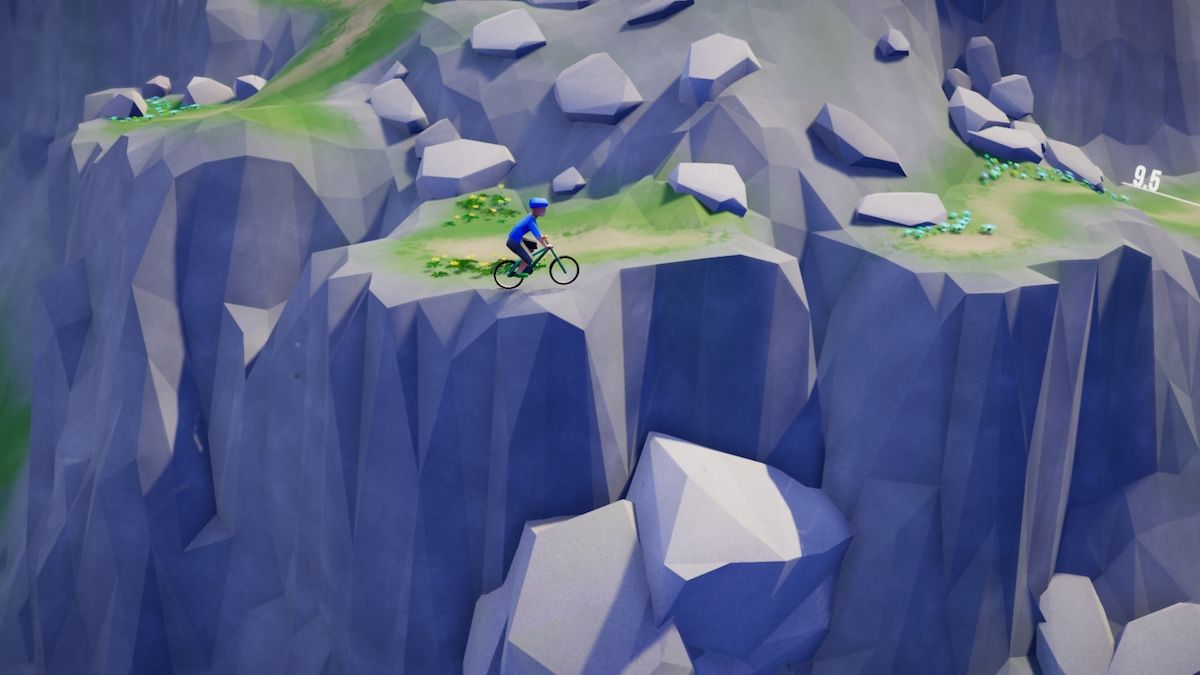It would be easy to dismiss Lonely Mountains: Downhill as another one of those games that revels in the grisly outcome for failing horribly at the most mundane of tasks. If you've been keeping tabs of the smaller releases over the past couple of years, you'll have noticed a kind of niche category (maybe not quite as definitive as a sub-genre per se) begin to surface and subsequently trend. The kind of silly, black humor-styled efforts that are often as much about the consequence of failure as they are the attempt at success. No matter how insignificant these tasks may be -- cycling with your young son through perilous death-traps, constructing bridges for vehicles to cross. What these games have in common is an embracing of unforeseen failure, of inevitable death. The nature of needing to start from scratch but knowing that all players want is to simply get back into proceedings, rather than be reminded of their first/tenth/hundredth failure. Failure is inevitable, no way around it.
Lonely Mountains follows in that vain of treating physical injury to your player-character as a dismissive affair, common even -- you can just hit restart, respawn and carry on as if nothing's ever happened, remember? It's a video game after all; who cares how many times you inadvertently force your character to smack head-first into the ground, into a nearby river or somewhere else even less comforting -- a few spurts of pixellated blood shooting up and out your damaged body. Developer Megagon Industries' crowdfunded mountain-biking offering isn't attempting some weird fusion of light-hearted imagery mixed with darker-leaning tones though, despite the low-poly visuals and clear emphasis on the grueling need to finally, at long last, memorize how not to die like so many times before. As we reported back in May of last year, Lonely Mountains' appeal extends beyond this playful macabre-lite delivery -- rather than indulging in the ridiculousness of its end result, this is a game that actually takes time to bury detail and subtle little suggestions in amongst its descending paths and treacherous routes alike.
The subtle physics and handling of its controls -- which mix up depending on the type of bike you select during the character/track select screen -- are just as prevalent as they were last year, as is the off-kilter and stripped-back use of sound design. Namely with its soundtrack, or lack thereof; instead, replaced by the ambient chirping of birds, crashing of water and more notably, the dug-in friction of bike wheels braking on the dirt beneath. For a game whose chosen art-style simplifies the environment to rigid shapes, its attention to detail (for starters) in the feel and handling of mountain-biking is unexpected at first, but incredibly satisfying the more you begin to unravel Lonely Mountains' intentions. And I'm not just talking about its multi-route options, the possibility to veer off the suggested path in pursuit of a short cut that may, or may not, chip a few seconds off your best time.
Accomplishing your goal as quickly and as efficiently as possible is still the aim here, but the much more interesting elements to be found -- and those that reinforce the need to revisit its small-if-branching assortment of courses time and time again -- come by way of its actual level design. Picking the game's environmental courses apart to see if that clearing or breaking away of foliage is indeed a secret route -- an exploit that can be converted into a secret route of sorts...or isn't anything but inevitable death by way of another, completely separate, hundred foot drop or such. Lonely Mountains goes a great job at balancing this suggestiveness between obscure and outright blatancy. Being as obvious as a literal fork in the path, or cleverly tucking itself behind certain environment details -- even staring you squarely in the face but disguising itself as mere environmental decoration.
The game does all this without over-egging the potential hilarity of its fail-states. There's no goofy or otherwise exerted visuals or animations to denote your failure. Nor is there a hint of silliness or slapstick humor that attempts to budge its way to the forefront, so as to paint Lonely Mountains as a game all about the would-be hilarity of assuming one thing only to be punished shortly thereafter. To ever think you could land your bike after a hundred foot drop without getting the direction/positioning of your bike's wheels spot on; the game, surprisingly, decides against indulging in comedy altogether and is all the better because of it. In refusing to parody the physicality and risk of downhill cycling, this withdrawal from the usual repertoire actually works to Lonely Mountains' advantage -- encouraging players to think more closely about the gameplay components and more importantly, how to get it right.
How and where to use the stamina meter to speed up, so as to make that pivotal jump coming up. Or when it might be fruitful to take a sharp bend at a faster speed, albeit at the risk of crashing. All the while, spotting these brief, suggestive but entirely optional short-cuts or would-be short-cuts and thinking, just maybe, it may prove useful to take another risk on top of the ones already administered. Surprising even the developer themselves with what one can spot and find amongst the environment -- one member of the team noting during my play-time, of what speed-runners, having access to an early build, could do with the game's physics and general design, in achieving rather nifty coverage of the terrain. There's a quicker/quickest way to progress here, but there's no right or wrong method in working it all about. To-be-expected walling-off of certain parts aside.
But even then, to so willingly push to see how wide and assorted Lonely Mountains' design really is, stands as the prime reason why Megagon Industries' clear passion for the sport -- and the thrill of the unpredictability -- translates so well. To not get so caught up in the aftermath and/or exploit it with unnecessary visual effects or amplified suggestion of comedy or humor. Lonely Mountains needs none of this, because its intentions instead, for the better, are in discovering things for yourself rather than being told that a failure here or a failure there is funny. The game is instead a bold and all-the-more involved questioning of the level design put before you. In working out if that slight little hill off the beaten path actually leads down to a secret path off-screen. The agency in discovering secrets, real or not, has been with us since the early days of the NES and Lonely Mountains: Downhill's gamble with player curiosity clearly calls back to such a timeless trait in game design. As such, it more than pays off, lending itself to a great mix of subtle guidance and tight control-orientated gameplay -- potentially giving Megagon (due out sometime this Summer) plenty of favor over their many, similarly-sized peers.




